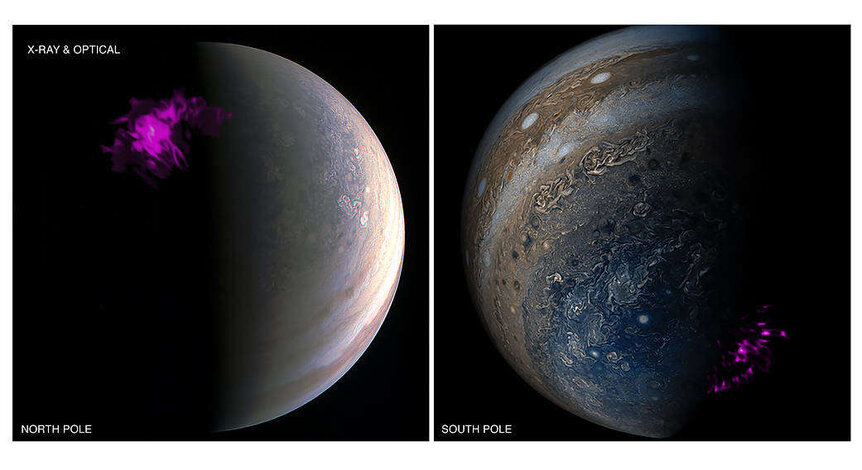Create a free profile to get unlimited access to exclusive videos, sweepstakes, and more!
Cool down, Jupiter; this is why you’re so overheated

Jupiter boasts auroras that make Earth’s look like mere fireworks. What nobody could be certain of until now is that these auroras also turn up the heat.
Why Jupiter’s atmosphere feels the burn has been something scientists have been trying to figure out for years. This was referred to as the “energy crisis”. New NASA/JAXA research has finally revealed that Jovian auroras, set off by its temperamental volcanic moon Io, are the reason this planet gets no relief from heatwave after heatwave. They heat all of Jupiter even though they only take up a tenth of its space. “That’s hot” is an understatement.
Astronomers from JAXA, the University of Leicester, NASA’s Goddard Space Flight Center and the National Institute of Information and Communications Technology (NICT) used data from the Keck Observatory in Hawaii to create a heat map of Jupiter’s upper atmosphere. Keck usually observes objects further away. What it saw on Jupiter finally gave away what was making the planet so sweltering, as JAXA researcher James O’Donoghue, who led a study recently published in Nature, and his colleagues found out.
“Keck is the largest telescope on Earth that specializes in infrared observations,” O’Donoghue told SYFY WIRE. “This beast of a telescope is usually used to look at very far-off targets in deep space, but its 10-meter wide mirror collects so much light that it allowed us to make global maps that definitively showed where all of Jupiter's thermal energy is located and where it's migrating.”
Volcanic Io has something to do with the rapidly changing auroras that make heat blaze throughout Jupiter. Auroras already make the poles of most giant planets hot enough, but this moon spews lava and other scorching volcanic gunk towards the planet it orbits at slightly over 2,200 pounds per second. Powered by the energy of Io’s eruptions, this material then accelerates to the poles of Jupiter via its magnetic field lines. Magnetic fields are actually abstract. Scientists’ visualizations of magnetic field lines tell them what direction magnetic forces are going in.
Io is the most volcanically active body in the solar system. Hundreds of volcanoes can erupt whenever, some sending lava plumes dozens of miles high. This sets off Jovian auroras and causes temperatures to rise, and how much is being ejected is one thing that determines the power and brightness of the auroras. This is partly Jupiter’s fault. There has been an eternal fight going on between the intense gravity of Jupiter and less significant gravitational pulls from its moons Europa and Ganymede, causing surface bulges and eventually eruptions on Io.
“If Io became particularly active, we would expect more energy deposition in the aurora, which ultimately leaks out around the rest of the planet as well,” O’Donoghue said. “In other words, with more volcanic eruptions on Io, I would expect more auroral and global heating on Jupiter.”
Another thing that could be behind all the heat transfer on Jupiter is an area in the sub-auroral region on Jupiter where there is localized heat. It is possible that this turns into a heatwave that travels towards the equator. There are several reasons this could be another culprit behind the heating of the entire planet. Not only is it the only energy source that isn’t right where auroras form (but still somehow produces as much heat as auroras, but it happens at the same time the Jovian magnetic field gets slammed with high-pressure solar wind.
Gas giants are kind of like enormous refrigerators. The poles are the heaters since auroras generate heat. Sideways winds try to deflect this heat as it migrates from the poles, but they are hardly strong enough. While Jupiter’s hot region did not show up that bright in observations, this is far from a sign that it’s cooled down. O’Donoghue sees its dimness as meaning it is still hot, but no charged particles from the solar wind are landing there. The phenomena just occur almost simultaneously without running into each other.
“Models tell us that such a compression of the magnetic field can lead to additional heating that would travel away from the aurora, and indeed the feature appeared to get farther from the ‘main auroral oval’ during the observing night as well, allowing us to estimate a speed,” he said.
Not that a human would survive Jupiter’s crushing gravity, but you will stay much cooler watching the light shows that happen here on Earth.



























